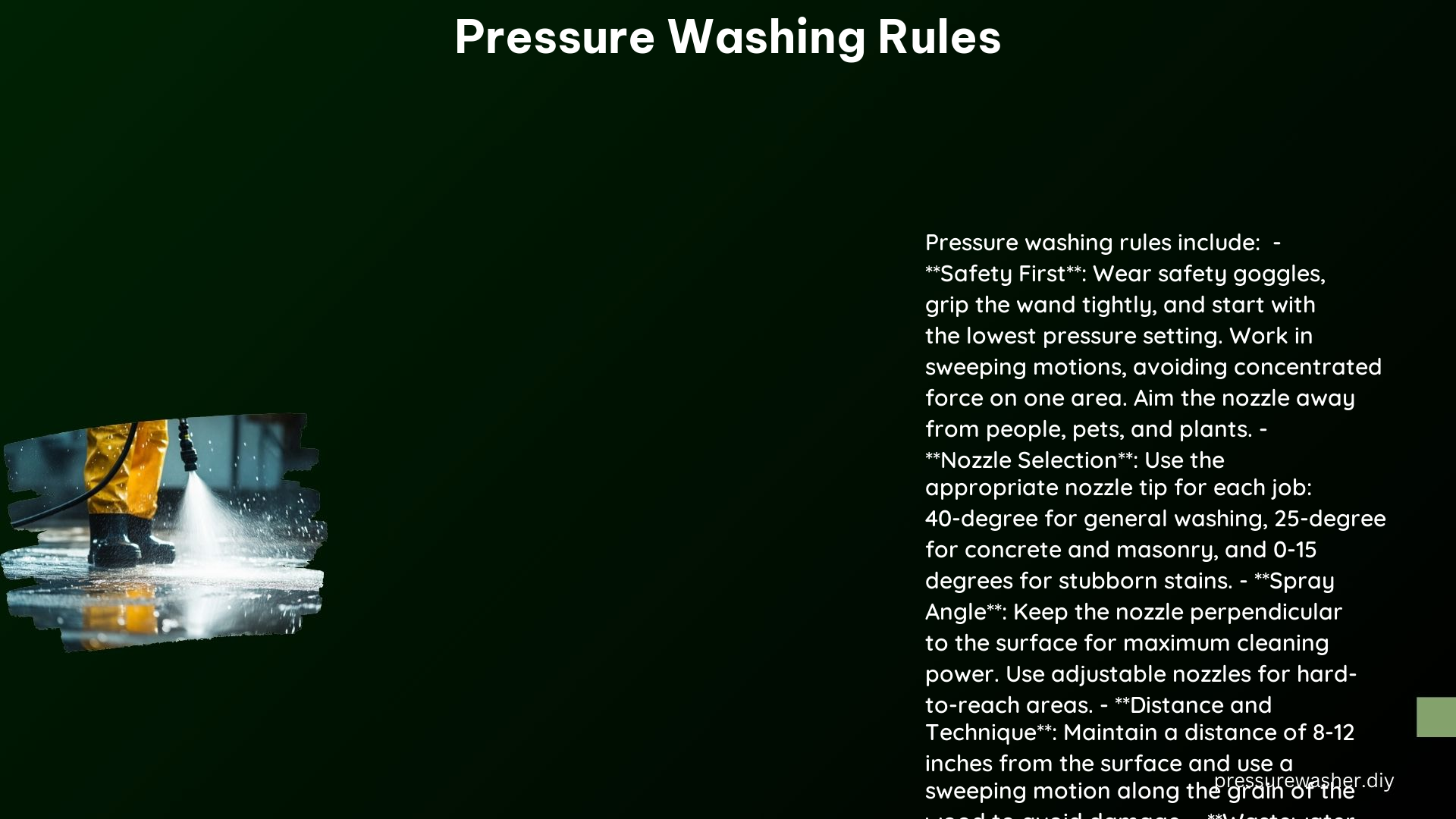Pressure washing is a powerful tool for cleaning a wide range of surfaces, from concrete driveways to wooden decks. However, it requires careful planning and execution to avoid damage and ensure safety. This comprehensive guide will provide you with the essential rules and considerations to keep in mind when pressure washing, covering safety precautions, surface-specific guidelines, environmental considerations, and technical specifications.
Safety Precautions
Distance and Angle
Maintaining the proper distance and angle is crucial when pressure washing to prevent damage to the surface. The recommended distance is 8 to 12 inches from the surface, and you should use a sweeping motion along the grain of the wood to avoid gouging or tearing the material. Applying too much pressure or holding the nozzle too close can cause significant damage, such as chipping paint, cracking wood, or etching concrete.
Electrical Safety
Pressure washing near high-voltage areas, such as electrical lines, conduits, or appliances, can be extremely dangerous and should be avoided. Always be aware of your surroundings and keep a safe distance from any electrical hazards. Wear proper safety gear, including ear and eye protection, as well as closed-toe shoes to protect your feet from debris.
Nozzle Control
Proper nozzle control is essential for safe pressure washing. Never point the nozzle at animals, people, or glass, as the high-pressure stream can cause serious injury or damage. Additionally, always wear waterproof clothing to prevent electrical shock, as water and electricity can be a deadly combination.
Surface-Specific Guidelines

Wooden Siding
When pressure washing wooden siding, use a wide-spray pattern and avoid high pressure to prevent damage. Start with a light touch and gradually increase the pressure as needed, keeping the nozzle moving in a sweeping motion along the grain of the wood.
Decks
Pressure washing decks requires a similar approach to wooden siding. Use a sweeping motion along the grain of the wood to avoid damage, and ensure the deck is clear of furniture and other items that could be damaged by the high-pressure water.
Painted Surfaces
For painted surfaces without loose paint, use a high-pressure water stream without soap to clean the surface. However, for surfaces being cleaned to remove paint or graffiti, it’s essential to block storm drains and contain the runoff to prevent environmental contamination.
Environmental Considerations
Water Disposal
Proper disposal of wastewater is crucial when pressure washing. Collect the wastewater, screen it to remove solids, and pump it to the sanitary sewer. Check with local authorities for specific requirements, as regulations may vary depending on your location.
Containment
Isolate the work area to prevent dust or debris from leaving the site. Ensure that the containment materials, such as tarps or barriers, are not torn or displaced and do not interfere with occupant and worker egress.
Technical Specifications
Pressure Settings
The correct pressure settings are essential for effective and safe pressure washing. Higher pressures can cause damage to surfaces, so it’s important to use the appropriate pressure for the material being washed. As a general guideline, concrete and masonry surfaces can withstand higher pressures (3,000-4,000 PSI), while wood and painted surfaces require lower pressures (500-1,500 PSI) to avoid damage.
Nozzle Tips
Different nozzle tips are designed for specific tasks. Narrow nozzle tips (0-15 degrees) deliver more force and are better suited for heavy-duty cleaning, while wider nozzle tips (25-40 degrees) are better for general washing and rinsing. Always select the appropriate nozzle tip for the job at hand to ensure efficient and safe pressure washing.
Additional Tips
Start with a Light Touch
When pressure washing, it’s always best to start with a light touch and gradually increase the pressure as needed. This approach helps to avoid damage to the surface and allows you to assess the effectiveness of the cleaning process.
Use the Correct Cleaning Method
Different surfaces may require different cleaning methods. For example, some surfaces may benefit from the use of soap or detergents, while others should be cleaned with water alone. Always use the appropriate cleaning method for the surface being washed.
Check Local Regulations
Before starting any pressure washing project, check with local authorities for any special requirements or restrictions, such as water usage during droughts or other environmental concerns. Adhering to these regulations is essential for responsible and sustainable pressure washing practices.
References
- Mi-T-M Corporation. (2023, February 22). Pressure Washing – The Ultimate Pressure Washer Guide. Retrieved from https://www.mitm.com/blog/pressure-washing-ultimate-guide/
- United States Environmental Protection Agency. (2024, July 3). How do RRP requirements apply to pressure washing? What containment and other preparation are required? Retrieved from https://www.epa.gov/lead/how-do-rrp-requirements-apply-pressure-washing-what-containment-and-other-preparation-are
- University of North Carolina Environment, Health and Safety. (n.d.). Power Washing Guidelines. Retrieved from https://ehs.unc.edu/topics/stormwater/pollution-prevention/pressure-washing/power-washing-guidelines/
- Reddit. (2023, August 27). How to do Commercial Pressure washing under water restrictions? Retrieved from https://www.reddit.com/r/pressurewashing/comments/1632tah/how_to_do_commercial_pressure_washing_under_water/
- Bob Vila. (2020, September 30). Pressure Washing – Dos and Don’ts. Retrieved from https://www.bobvila.com/articles/the-dos-and-donts-of-pressure-washing/
